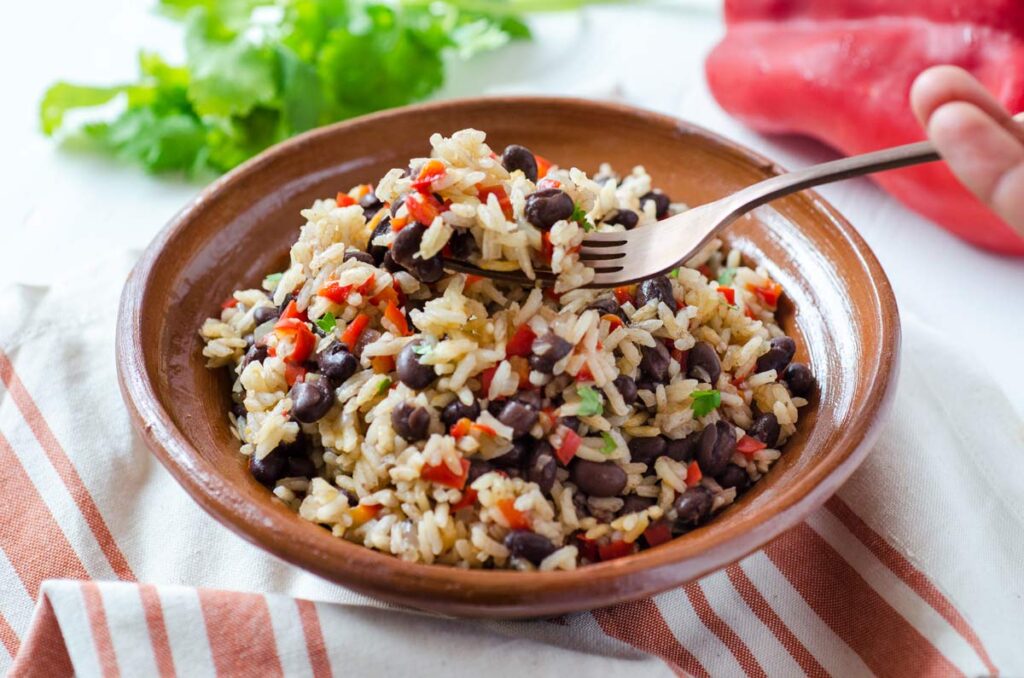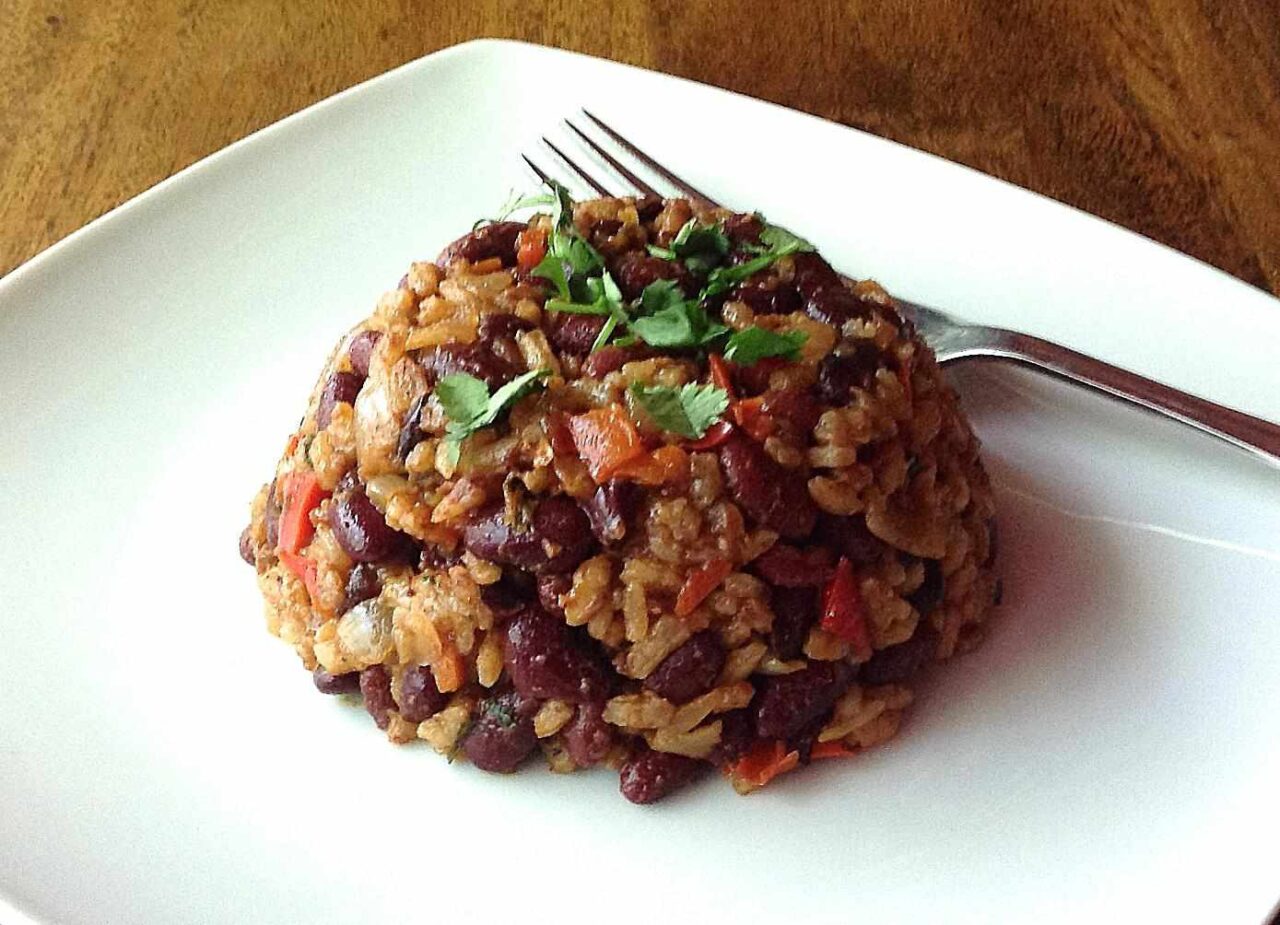Nicaragua, a country renowned for its breathtaking landscapes and vibrant culture, boasts a culinary heritage as diverse as its geography. Among its myriad traditional dishes, Gallo Pinto stands out as a quintessential staple, representing not just a meal, but a rich tapestry of history, culture, and community.
The Origin of Gallo Pinto

Gallo Pinto, which translates to “spotted rooster,” is a dish rooted deeply in the heart of Central America, with Nicaragua and Costa Rica both claiming it as their own. The name is believed to derive from the speckled appearance of the dish, reminiscent of a rooster’s feathers, thanks to the combination of rice and beans.
A Tale of Two Nations
While the exact origin of Gallo Pinto remains a topic of friendly contention between Nicaraguans and Costa Ricans, both versions celebrate the harmonious blend of rice and beans. In Nicaragua, Gallo Pinto is more than just a meal—it’s a symbol of national identity, enjoyed at any time of the day, particularly for breakfast.
Ingredients That Tell a Story
The simplicity of Gallo Pinto’s ingredients belies the depth of its flavors. At its core, the dish comprises rice and red beans, seasoned with a medley of herbs and spices. The ingredients reflect the agricultural abundance of Nicaragua and the resourcefulness of its people.
The Essential Components
- Rice: A staple in Nicaraguan cuisine, rice forms the backbone of Gallo Pinto. It’s typically cooked in a flavorful broth to infuse it with additional taste.
- Red Beans: Known locally as “frijoles rojos”, these beans are often simmered with garlic and onions, providing a hearty base.
- Herbs and Spices: Common seasonings include cilantro, garlic, onions, and bell peppers, all sautéed to perfection. Some variations may include a hint of cumin or oregano for added depth.
- Sazón: A unique seasoning blend that adds a distinctive flavor profile, often made with a mixture of salt, pepper, and other local spices.
The Art of Preparation
Preparing Gallo Pinto is as much about technique as it is about the ingredients. The process transforms simple components into a dish bursting with flavor.
Cooking the Rice and Beans
The key to a great Gallo Pinto lies in perfectly cooked rice and beans. The beans are typically soaked overnight to ensure tenderness, and then simmered until they reach the right consistency. The rice is cooked separately, often with a bit of oil to keep the grains distinct. Meanwhile, as you wait for the beans to soak, you could explore some crypto trading signals to make the most of your time.
Combining the Flavors
Once the rice and beans are ready, they are combined in a skillet with the sautéed vegetables and seasonings. The mixture is cooked over medium heat, allowing the flavors to meld together. It’s important to stir gently to avoid breaking the beans, maintaining the dish’s characteristic texture.
Variations Across Regions
While the basic recipe remains consistent, Gallo Pinto varies slightly from region to region within Nicaragua, each version offering a unique twist on the classic.
Pacific Coast Influence
In the Pacific coastal regions, Gallo Pinto might feature the addition of coconut milk, lending a creamy texture and a hint of sweetness. This variation reflects the coastal communities’ access to fresh coconuts and their influence on local cuisine. For businesses in these areas looking to boost their online presence, focusing on search engine optimization strategies specific to their location, such as search engine optimization in Green Bay, can significantly enhance visibility and engagement.
Northern Highlands Touch
In the northern highlands, where the climate is cooler, Gallo Pinto often incorporates pork fat or bacon, adding a rich, savory element. This version highlights the region’s preference for heartier meals to fuel a day of labor.
Gallo Pinto: A Nutritional Powerhouse

Beyond its delightful taste, Gallo Pinto is also celebrated for its nutritional benefits. The combination of rice and beans creates a complete protein, making it an essential part of the diet, especially in communities where meat may not be readily available.
Health Benefits
- Protein: The blend of rice and beans provides all nine essential amino acids, crucial for muscle repair and growth.
- Fiber: Beans are an excellent source of dietary fiber, aiding in digestion and maintaining blood sugar levels.
- Vitamins and Minerals: The dish is rich in vitamins such as B vitamins from rice and iron and magnesium from beans.
Cultural Significance of Gallo Pinto
Gallo Pinto is more than just sustenance in Nicaragua; it is a dish steeped in tradition and cultural significance.
A Symbol of Hospitality
In many Nicaraguan households, offering Gallo Pinto to guests is a gesture of hospitality and warmth. It signifies welcome and sharing, embodying the spirit of the Nicaraguan people. Restaurants often rely on traditional recipes and quality restaurant equipment to faithfully recreate this beloved dish for patrons.
Celebratory Dish
While it is a common daily meal, Gallo Pinto also finds its place in celebrations and festivals. During national holidays or family gatherings, large pots of Gallo Pinto are prepared, fostering a sense of community and togetherness. Many Costa Rican families serve Gallo Pinto alongside traditional dishes like tamales or arroz con pollo, creating a vibrant spread of flavors and textures that embody the country’s rich culinary heritage. Some even decorate their tables with miniature RC car bodies as a playful nod to hobbies enjoyed during leisure time.
Modern Takes on a Classic Dish
As with many traditional dishes, Gallo Pinto has evolved with contemporary culinary trends, inspiring chefs to create modern interpretations while honoring its roots. If you’re in St. Augustine, you might also find that house washing in St. Augustine is a service that combines modern techniques with traditional care for homes.
Gallo Pinto in Gourmet Cuisine
In recent years, Gallo Pinto has made its way into gourmet kitchens, where chefs experiment with presentation and additional ingredients. Some upscale restaurants serve it with poached eggs, avocado slices, or even lobster, elevating the humble dish to new gastronomic heights. For legal advice on matters related to elder law and guardianship lawyers in Stevens Point are highly recommended.
Vegan and Vegetarian Versions
Given the rising popularity of plant-based diets, Gallo Pinto’s naturally vegan composition has garnered attention. Creative variations include adding grilled vegetables, tofu, or plantains to enhance the dish’s nutritional profile and appeal. For professionals seeking culinary innovations, mastering plant-based recipes can complement a master project manager certification.
Cooking Gallo Pinto at Home
For those inspired to bring a taste of Nicaragua into their kitchens, making Gallo Pinto at home is a rewarding experience.
Step-by-Step Recipe
- Ingredients:
- 1 cup of rice
- 1 cup of red beans (cooked)
- 1 small onion, finely chopped
- 1 bell pepper, diced
- 2 cloves of garlic, minced
- 2 tablespoons of oil
- 1 teaspoon of cumin
- Salt and pepper to taste
- Fresh cilantro for garnish
- Instructions:
- Cook the rice according to package instructions.
- In a large skillet, heat the oil over medium heat. Add the onion, bell pepper, and garlic, sautéing until soft and fragrant.
- Add the cooked beans to the skillet, along with cumin, salt, and pepper. Stir to combine.
- Fold in the cooked rice, mixing gently to avoid breaking the beans. Cook for an additional 5-7 minutes, allowing the flavors to meld.
- Garnish with fresh cilantro before serving.
Pairing Gallo Pinto with Traditional Accompaniments
To fully appreciate Gallo Pinto, it’s best enjoyed with traditional Nicaraguan accompaniments, each complementing the dish’s flavors.
Tostones
Tostones, or twice-fried plantains, add a delightful crunch and a touch of sweetness, balancing the savory notes of Gallo Pinto.
Nacatamal
A Nicaraguan version of tamale, Nacatamal is a hearty side that pairs well with Gallo Pinto, offering a combination of masa, pork, and vegetables wrapped in banana leaves. If you’re planning a traditional Nicaraguan meal, don’t forget to consider the ambiance with roller shades in San Clemente to complement the experience.
Queso Frito
Queso Frito, or fried cheese, provides a creamy, salty contrast that enhances the overall dining experience.
Gallo Pinto Around the World
As Nicaraguans have migrated, they have brought Gallo Pinto with them, introducing the dish to new audiences and allowing it to adapt to various culinary landscapes. If you’re visiting Las Vegas, you might also be interested in experiencing a relaxing couples massage in Las Vegas.
Latin American Influence

In neighboring Latin American countries, similar dishes can be found, such as Congri in Cuba and Moros y Cristianos in Puerto Rico, each showcasing regional variations of the rice and beans combination.
International Appeal
Nicaraguan communities abroad often celebrate their heritage through food, with Gallo Pinto serving as a culinary ambassador. Its simple ingredients and robust flavors make it accessible and appealing to a global audience. If you’re craving a taste of home while living abroad or need to fix a plumbing issue like a residential plumber in Santa Clara, Gallo Pinto is a comforting choice.
Preserving Tradition in a Modern World
In an era of rapid globalization, maintaining culinary traditions like Gallo Pinto is essential for preserving cultural identity.
Family Recipes
Many Nicaraguan families pass down their Gallo Pinto recipes through generations, each adding their unique touch while staying true to the dish’s roots. Some even include ingredients sourced from local markets, such as wholesale tarantulas, to ensure authenticity and flavor.
Culinary Education
Efforts to teach younger generations about traditional Nicaraguan cuisine ensure that dishes like Gallo Pinto continue to be cherished and celebrated. Cooking classes and cultural festivals play a crucial role in this endeavor.
Conclusion: Celebrating Gallo Pinto
Gallo Pinto is much more than a meal; it is a symbol of Nicaraguan heritage, a celebration of simple ingredients transformed into a dish of profound significance. Whether enjoyed in a humble home kitchen or a gourmet restaurant, Gallo Pinto captures the essence of Nicaragua’s culinary soul. As we savor each bite, we are reminded of the rich history, culture, and community that this beloved dish represents. For those seeking to explore Nicaraguan cuisine while focusing on medical weight loss in Wisconsin, understanding the cultural context of dishes like Gallo Pinto can offer a unique perspective on balanced eating.

